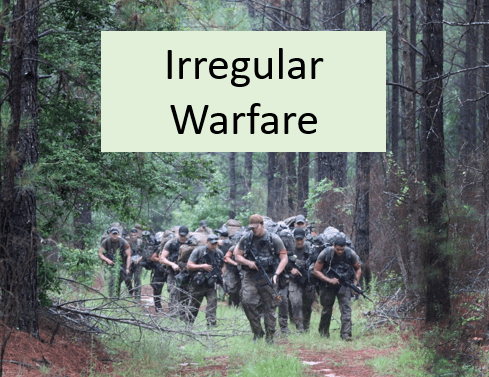
LTG (Retired) Charles Cleveland has provided an interesting look at the past 40 years of the history of U.S. special operations. He combines his personal observations – tracing his career in U.S. Army Special Forces – with an analytical approach to the many conflicts U.S. SOF participated in. A result of this study are his recommendations for the restructuring of the U.S. special operations community and its approach to irregular warfare (IW).
The American Way of Irregular War: An Analytical Memoir describes how the United States has approached conflicts in which armed civilian or paramilitary forces are the primary combatants. This form of warfare emphasizes the importance of local partnerships and gaining legitimacy and influence among targeted populations – sometimes referred to as population-centric operations.
Cleveland’s career – most of it spent as a Special Forces officer – saw him participate in operations around the world at the tactical level. He experienced the Cold War in Europe, counterinsurgency and counternarcotics operations in Central and South America, as well a significant time in subsequent conflicts. In addition, he spent a considerable amount of his career in the upper echelons of command – retiring as the commander of the United States Army Special Operations Command (USASOC).
Cleveland finds that the country’s irregular warfare efforts were largely successful at the tactical level. However, he argues that the U.S. has failed to achieve its strategic objectives in nearly every population-centric military campaign over the past four decades. The problem, according to Cleveland, is that the U.S. lacks the concepts and doctrine required to be effective in population-centric conflicts and that it lacks the organization to conduct irregular warfare effectively.
He provides three recommendations that require a transformation of the SOF community. He proposes action by the U.S. Congress, the President, and others. These proposals include the establishment of a bi-partisan commission to review the U.S. performance in irregular warfare, a reorganization of the executive branch and DoD, and the establishment of an institution (independent of the government) that would be a center of excellence for the study of irregular warfare.
Cleveland’s account of U.S. irregular warfare over the past four decades resonated with me. I served 40 years in the U.S. Army Special Forces during the same time frame – we share many of the same experiences. Reading his account of U.S. IW had me revisiting time spent in Europe on Flintlock exercises, on light infantry JCETs to Latin America, and my participation in Operations Provide Liberty, Desert Shield, Desert Storm, Provide Comfort, Uphold Democracy, OEF, OIF, and others. It was a trip down memory lane for this old retired soldier.
Cleveland’s recommendations deserve serious consideration. Hopefully the publication will prompt action by Congress and the Department of Defense. This is an excellent publication and is available to read online or download from the RAND website. Many readers, including this one, will likely opt to buy the printed version to place on their ‘reference book shelf’.
*********
The American Way of Irregular War: An Analytical Memoir, by Charles T. Cleveland with Daniel Egel, RAND Corporation, 2020, 276 pages, PDF.
https://www.rand.org/content/dam/rand/pubs/perspectives/PEA300/PEA301-1/RAND_PEA301-1.pdf
Photo: Special Forces candidates assigned to the U.S. Army John F. Kennedy Special Warfare Center and School patrol through a wooded area during the final phase of field training known as Robin Sage in central North Carolina, July 9, 2019. Robin Sage is the culmination exercise and has been the litmus test for Soldiers striving to earn the Green Beret for more than 40 years. (U.S. Army photo by K. Kassens)